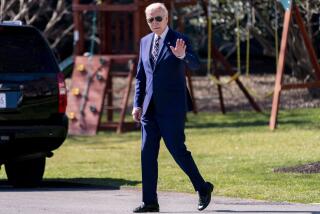Congress’ jobs bill vs. the White House plan
- Share via
Reporting from Washington — Unemployment rates rose steadily last year, from 7.7% in January to a peak of 10.1% in October. In his State of the Union address Wednesday, President Obama told lawmakers that “jobs must be our No. 1 focus in 2010.”
Two approaches to creating jobs
Government can attempt to create jobs by cutting taxes, allowing employers to keep more of their profits with the hope that they will spend it on hiring.
Government spending is another approach to job creation.
Infusing cash into public programs and infrastructure projects enables federal, state and local agencies to hire more workers.
Government spending also can provide incentives for growth through loans, subsidies and tax credits for certain industries.
Congress to play a crucial role
In December, the House passed a $154-billion jobs bill.
The package would invest $48.3 billion in infrastructure projects aimed at putting people to work to rebuild roads, clean the nation’s air and water systems and renovate government buildings.
That bill also would dedicate $26.7 billion to fund jobs for teachers, firefighters, police and other public servants.
An additional $79 billion would extend unemployment insurance and extend subsidies for the unemployed to buy insurance, in addition to other measures.
Similar action in the Senate is pending, but the specifics of the proposal are unclear.
Administration’s budget blueprint
In his 2011 budget released Monday, Obama dedicated $100 billion to fund a jobs bill that would include tax cuts for small businesses, as well as investments in infrastructure and clean energy.
The small-business tax cut -- which was not included in the House bill -- would cost $33 billion and reward companies that hire new employees or increase salaries for existing workers this year.
It is unclear how the administration proposes to spend the remaining $67 billion.
Rob Nabors, deputy director of the Office of Management and Budget, indicated that Obama was interested in dedicating upward of $50 billion to infrastructure and clean-energy investments.
The president also wants to see a continuation of unemployment benefits, health insurance assistance and food stamp programs, Nabors said.
Those programs would be funded independently of the $100-billion jobs bill.
Money is the bottom line
The Senate will likely use the president’s budget as a guideline as it crafts its own jobs bill.
In the last year, Republicans have been unwilling to cooperate with the Democratic majorities in the House and Senate.
Party wrangling in the midst of an election year could present another barrier to swift passage of a bill.
More to Read
Sign up for Essential California
The most important California stories and recommendations in your inbox every morning.
You may occasionally receive promotional content from the Los Angeles Times.













